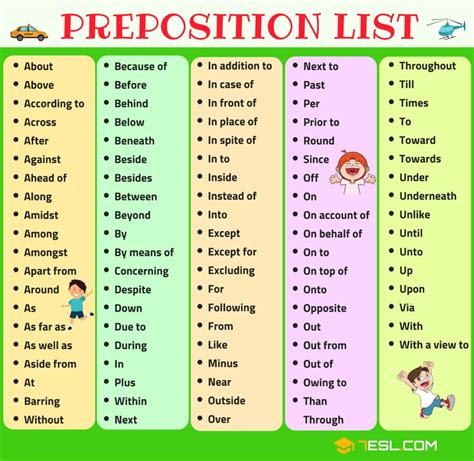Prepositions are a fundamental part of the English language, yet they can be one of the most challenging aspects for learners to master. With a vast array of prepositions to choose from, each with its own set of rules and exceptions, it's no wonder that even native speakers can sometimes struggle to use them correctly. In this article, we'll explore five preposition tips to help you improve your understanding and usage of prepositions in English.
Understanding the Basics of Prepositions

Before we dive into the tips, it’s essential to understand what prepositions are and how they function in a sentence. Prepositions are words that show the relationship between a noun or pronoun and other words in a sentence. They can indicate location, direction, time, manner, and more. Examples of common prepositions include in, on, at, by, and with. To use prepositions effectively, you need to understand the context in which they are being used.
Key Points
- Prepositions show the relationship between a noun or pronoun and other words in a sentence
- Understanding the context is crucial for using prepositions correctly
- Prepositions can indicate location, direction, time, manner, and more
- Practice is key to mastering preposition usage
- Be aware of common preposition mistakes and exceptions
Tip 1: Learn the Most Common Prepositions
There are over 150 prepositions in the English language, but some are used much more frequently than others. Focusing on the most common prepositions, such as in, on, at, by, with, and from, can help you build a strong foundation. Make a list of these prepositions and practice using them in different contexts to improve your understanding of how they function.
| Preposition | Example Sentence |
|---|---|
| In | I am in the kitchen. |
| On | The book is on the table. |
| At | She is at the store. |
| By | The painting was created by a famous artist. |
| With | I am going with my friends. |
| From | I received a gift from my sister. |

Tip 2: Practice, Practice, Practice
Like any skill, mastering prepositions requires practice. Try to use prepositions in your daily writing and speaking to become more comfortable with their usage. You can also find online resources, such as quizzes and exercises, to help you practice. Remember, the more you practice, the more natural using prepositions will become.
Tip 3: Be Aware of Common Mistakes
Even native speakers can make mistakes when using prepositions, so it’s essential to be aware of common errors. For example, confusing in and on is a common mistake, as is using at instead of in for locations. Being mindful of these mistakes can help you avoid them and improve your overall usage of prepositions.
Tip 4: Learn Preposition Idioms and Phrasal Verbs
Preposition idioms and phrasal verbs are expressions that include a preposition and are used to convey a specific meaning. Examples include get on with (to continue doing something) and look forward to (to anticipate something with pleasure). Learning these expressions can help you sound more natural and fluent in English.
Tip 5: Use Prepositions in Context
Finally, it’s crucial to use prepositions in context to understand how they function in different situations. Try to use prepositions in sentences that reflect real-life scenarios, and pay attention to how they are used in the sentences. This will help you develop a deeper understanding of preposition usage and improve your ability to use them correctly.
What is the best way to learn prepositions?
+The best way to learn prepositions is through a combination of practice, context, and awareness of common mistakes. Start by learning the most common prepositions and practice using them in different contexts. Be mindful of common mistakes and exceptions, and try to use prepositions in sentences that reflect real-life scenarios.
How can I improve my preposition usage in writing?
+To improve your preposition usage in writing, try to read and write regularly, paying close attention to how prepositions are used in context. You can also practice using prepositions in your daily writing, such as in journal entries or short stories. Additionally, seeking feedback from a teacher or tutor can help you identify and correct common mistakes.
What are some common preposition mistakes to avoid?
+Some common preposition mistakes to avoid include confusing in and on, using at instead of in for locations, and using by instead of with for instruments. Being aware of these mistakes can help you avoid them and improve your overall usage of prepositions.
Mastering prepositions is a process that takes time and practice, but with persistence and dedication, you can improve your understanding and usage of prepositions in English. By following these five preposition tips and practicing regularly, you’ll be well on your way to becoming a proficient user of prepositions and enhancing your overall language skills.



